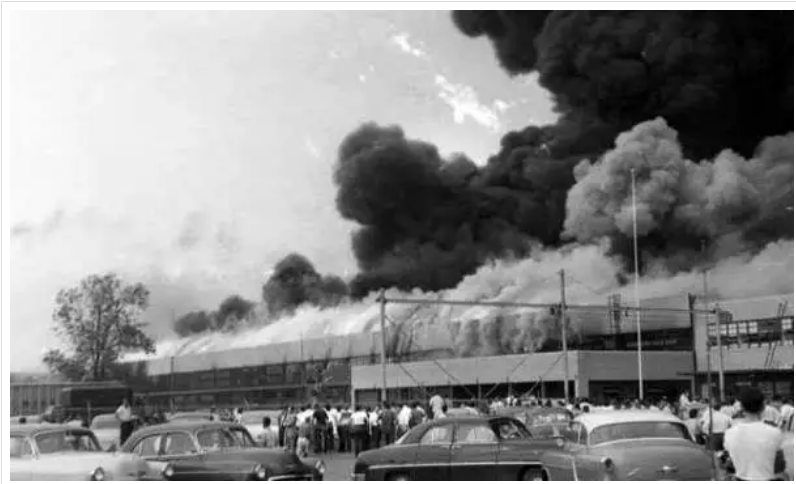
The 1953 Hydra-Matic fire in Livonia, Michigan forever changed the way the Motor City’s carmakers do business.
August 12, 1953 was a bad day for General Motors. At 3:45 PM that Wednesday afternoon, the modest fire department in Livonia, Michigan, about 15 miles northwest of downtown Detroit, received a frantic phone call. The giant Hydra-Matic plant on Plymouth Road was on fire, and the flames were already spreading throughout the building.
Built in 1949, the 1.5-million square-feet Hydra-Matic plant was one of GM’s biggest and most modern facilities, turning out 4,000 automatic transmissions per day for the Oldsmobile, Pontiac, and Cadillac divisions. The factory also supplied Hydra-Matics to competitors Lincoln, Nash, Hudson, and Kaiser. But a spark from a welder’s torch set off a fire in a conveyor system that carried solvent through much of the building, and soon the entire facility was ablaze.

The small fire-fighting teams of the plant and the city of Livonia were totally outmatched by the fire, while red tape delayed the nearby Detroit fire department for more than 20 minutes. The fire would not be controlled and in a matter of hours the complex was a total loss, estimated at $55 million (more than a half billion in 2023 dollars). Three workers from GM’s Ternstedt division, which occupied a portion of the plant, were trapped and suffocated, but miraculously, the rest of the 4,000 GM employees escaped with 15 receiving minor injuries. In the cleanup, two more workers were electrocuted when a crane cable contacted high-tension wires.
The loss of the plant threw GM’s 1953 production plans into chaos. All Cadillac production and more than 85 percent of the Olds and Pontiac output depended on Hydra-Matic transmissions. More than 26,000 workers were furloughed and production estimates were slashed by 100,000 cars as the automaker scrambled to respond with a corporation-wide emergency plan called Operation Hydra-Matic.

Just eight days after the fire, GM signed a deal with Kaiser Motors to lease 1.5 million square feet of its massive plant at Willow Run, another 10 miles west of Livonia, the one originally built by Ford to build B-24 Liberator bombers for World War II. Thousands of mechanics and millwrights were flown in from all over the country to rebuild the Livonia equipment that could be salvaged and install it at Willow Run. A small, interim production line was thrown together at GM’s Riopolle Street plant in central Detroit where the Hydra-Matic was originally manufactured, and it was running by October 18.
With no supply of Hydra-Matics available in the meantime, the Cadillac and Oldsmobile divisions hastily re-engineered their chassis and engines to accept the totally different Buick Dynaflow transmission, while Pontiac adapted the less expensive Chevrolet Powerglide. As a result, around 28,000 Cadillacs and thousands of Oldsmobiles (number unspecified) produced in 1953 were equipped with Dynaflow transmissions, and around 18,000 Pontiacs were sold that year with the Chevy automatic gearbox.
These swaps were engineered in a matter of weeks, and dealers were relieved to receive the modified cars. They dreaded the prospect of trying to sell stick-shift models or being stuck with no cars at all. And the ad-hoc transmission arrangments got the assembly lines moving, allowing tens of thousands of GM workers to return to their jobs.

More than 2,500 technicians, engineers, and contractors, working two 10-hour shifts per day, got the Willow Run plant (in color above) up and running on November 4, and by December 18, the 8,000 production workers were matching the Livonia plant’s daily output—only 128 days after the fire. In a show of good will, GM sent the first transmissions to its rival automakers and clients: Kaiser, Lincoln, Hudson, and Nash.
In the insurance industry, the Hydra-Matic disaster is still referenced as the worst industrial fire in U.S. history, and it changed the way the insurers do business, writing policies and compensating losses. It also revolutionized factory construction for the Motor City’s automakers, institutionalizing sprinkler systems, firewalls, and other fire-control measures. It was also a wakeup call for the municipalities and their fire departments where large manufacturing plants are based.
GM soon bought the Willow Run facility outright, expanding and operating the plant and producing everything from Corvairs to M16A1 army rifles until it closed in 2010. The American Center for Mobility, a road-testing facility for autonomous vehicles, is now based there. On the site of the destroyed Plymouth Road plant an Inland Fisher Body facility was constructed, which later became a GM trim plant and is today occupied by Roush Industries.



